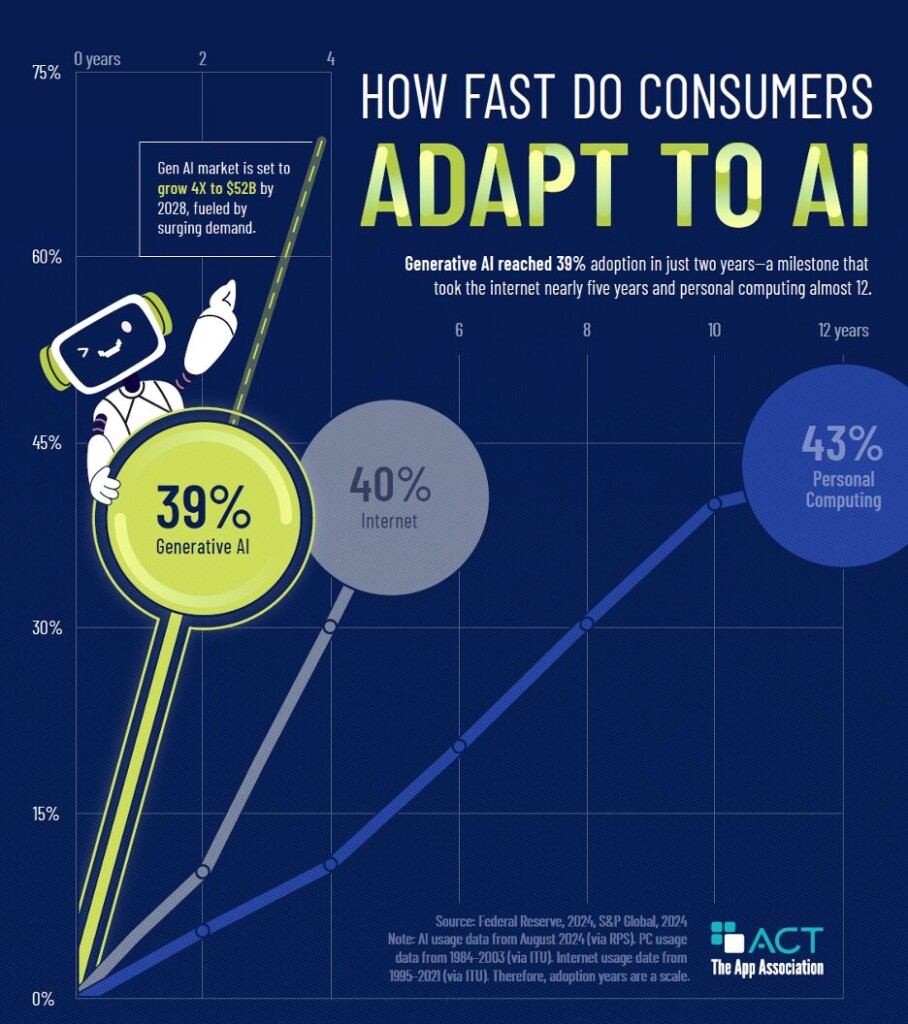Generative AI has arrived, faster and more transformative than anyone could have anticipated. Unlike previous technological revolutions, which took years to reach mass adoption, AI has surged into workplaces and everyday life in record time.
New data shows that nearly 40 percent of U.S. adults aged 18 to 64 are already using generative AI, with almost one in three leveraging it daily or multiple times per week. To put that into perspective, it took nearly five years for the internet to reach similar levels of adoption and a full 12 years for personal computers to achieve comparable penetration. AI isn’t a slow-moving wave, it’s a tidal force reshaping how we work, create, and communicate.

The AI Stack is a Web of Cooperative Innovation
The AI boom isn’t happening in a vacuum. Startups and established cloud service providers are working together in an innovation cycle that benefits both sides and consumers. Large technology companies act as key enablers of AI innovation, providing startups with the funding, computing power, and market access needed to turn ambitious ideas into transformative technologies. For example, Open AI’s GPT-4, one of the most powerful AI models to date, was trained on Microsoft Azure supercomputers, a level of computing power that would be impossible for an independent startup to access alone. Partnerships like these give AI startups the resources to compete at scale, ensuring that breakthrough innovations aren’t bottlenecked by infrastructure limitations.
Major firms also provide distribution channels, data access, and mentorship, enabling startups to refine their technology and bring it to market more quickly. Corporate venture funding and acquisitions play a crucial role in scaling AI breakthroughs, allowing startups to leverage the global reach of an established platform. For entrepreneurs and investors, this dynamic creates strong incentives to pursue bold AI ideas. If a startup succeeds, it can either scale independently with support from partnerships with incumbent cloud service providers or integrate into a larger ecosystem through acquisition. Either way, innovation thrives.
Research has also confirmed that merger and acquisition (M&A) activity has spurred research and development (R&D) in tech, not just for the acquirer but also for its competitors, who ramp up their own innovation efforts in response. Killing acquisitions would eliminate an important avenue to accelerate competition by injecting new talent, technology, and ideas into the market.
The Policy Challenge: Letting AI Innovation Thrive
Yet, despite the AI industry’s ability to adapt to address emerging challenges, policymakers in the recent past have expressed keenness to intervene in the AI industry. Instead of allowing free-market forces and consumers to determine winners and losers, heavy-handed policies risk freezing innovation in place, making it harder for startups to compete and scale.
For example, in 2024, the EU scrutinized Amazon’s $1.7 billion iRobot acquisition, fearing it would stifle competition. The result was a terminated deal that left iRobot struggling, forcing it to lay off a third of its workforce, showing that blocking deals that are considered pro-competitive under U.S. law has real world consequences.
Instead of bolstering competition, the intervention weakened a key AI-driven company, reducing consumer choice and innovation. Competition policy should not be about picking winners and losers. It should be balanced and forward-thinking, ensuring that AI startups continue to access funding, infrastructure, and partnerships that drive innovation.
The Road Ahead: Trusting Market Forces to Drive AI Innovation
AI is evolving at a breakneck pace, and consumer adoption is outpacing even the most optimistic predictions. The acceleration of consumer demand for AI services underscores the rapidly growing costs of government interventions that would freeze things in place, robbing the marketplace of offerings to meet this demand.
Policymakers have a choice: either support AI investment and innovation or risk slowing progress with unnecessary barriers.